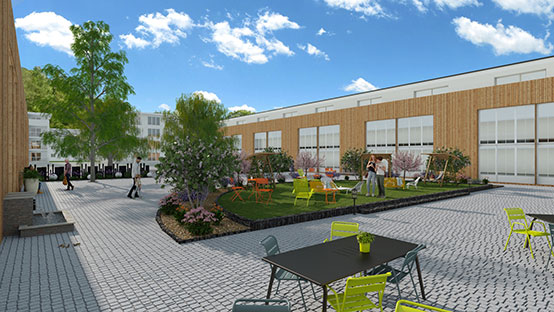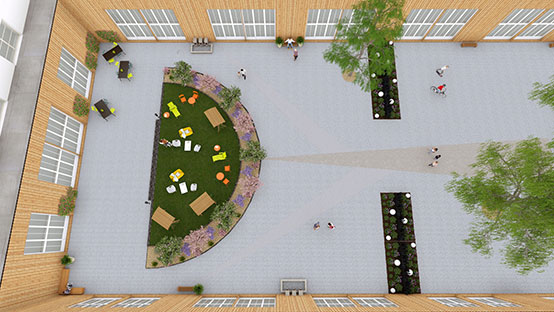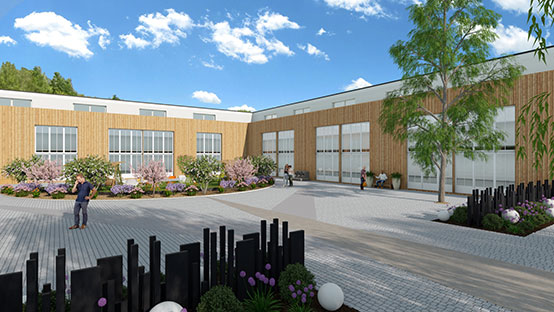Commercial properties can be as simple as a small warehouse or as large and complex as a university campus. Either way, they have special landscaping needs.
That’s why commercial landscape designs are so important.
Builders and designers need to create detailed landscape designs that provide the perfect combination of durability, beauty, and function.
So let’s take a quick look at…
- Commercial landscape design basics
- What to include in your designs
- How to design your commercial landscape
- Benefits of using commercial landscape renderings in your designs
Let’s start with the basics.
What is Commercial Landscape Design?
Commercial landscape design is a type of landscaping that involves planning greenery, hardscapes, lighting and furnishings around a commercial building. The same company that creates the designs will often do the installation and maintenance of the landscaping.
In the past, landscaping contractors used pen and paper or complicated CAD programs to create their plans. But now with modern design programs like Cedreo, it’s easy for anyone to create commercial landscape plans.

What to Include in Your Commercial Landscape Design
Planning a commercial landscape layout for a client? Don’t forget to include these basic items.
Construction and Hardscapes
Residential landscaping tends to be more about the grass and plants. But commercial landscaping relies more on hardscapes and permanent construction elements than residential landscaping.
These could include:
- Walkways and sidewalks
- Retaining walls
- Fences
- Fountains
- Paved patios
- Decks
Why are these important? Construction and hardscape design elements contribute to the overall function of the exterior space. For example, paved paths help direct the flow of traffic and lead people to the building’s entrance.
Lighting
Lighting is very important in commercial landscapes for two big reasons:
- Aesthetics – A business should stand out and give a good impression day or night. Well-designed landscape lighting does that by lighting up your business and grabbing the attention of passersby.
- Safety – Commercial areas need to be safe for the public. Landscape lighting around entrances and pathways helps customers and employees see where they’re walking.
Plants & Gardens
Biophilic design is the idea that people are happier when they feel closer to nature. It’s an important part of interior design and just as important in landscape design. This is especially true in urban areas that are filled with asphalt and concrete.
So if you can incorporate plants and gardens into the design, it will create a landscape that helps reduce stress and fatigue while boosting moods and imagination.
Furnishings
Furnishings are an extremely important part of commercial landscaping since they add to the function of the layout. What are some common furnishings you see in commercial landscapes?
- Benches
- Bike racks
- Grills
- Planters
- Garbage bins
- Picnic tables
- Umbrellas
- Playgrounds
- Gazebos
Add the right furnishings and you’ll give employees and customers a place to relax, eat lunch, and even work.
*It can be tough to find a design program that gives you the freedom to include all of these elements in your landscape designs. We suggest you check out Cedreo. It’s super easy to use and has a big design library with everything you need to create commercial landscape designs.
Designing Your Commerical Landscape
Need an easy way to design a commercial landscape for a client? Here’s how to do it with a program like Cedreo. You might be surprised at how simple it is.
Site Plan
All landscape designs start with a site plan. A site plan shows the entire property including any permanent structures. With a basic 2D site plan, you know how much space you have left for landscaping.
How can you create a site plan in Cedreo? There are two ways.
- Draw the site plan by scratch. Take pictures and measurements of any buildings on the property. Then draw the buildings in Cedreo.
- Import an existing site plan. Ask your client for a copy of their site plan blueprint. Import it into Cedreo as an image, set the scale, and trace over it with Cedreo’s drawing tools.
Once you’ve got the site plan ready, now it’s time to start adding the landscaping.
2D Landscape Plan
Your 2D landscape design shows the layout from above and should include the location of greenery, hardscapes and outdoor furniture.
In Cedreo, you can take care of the basics in the Exterior tab. There you can add features like a lawn and paved driveway or parking.
Then in the Furnishings and Materials tabs, you can finish the landscape plan.
- Choose from thousands of different types of shrubs, plants, trees, and potted plants.
- Add exterior lighting.
- Drag and drop outdoor furniture like tables and chairs, pergolas, fences, and awnings.
- Build retaining walls and paved patios.
- Virtually every element is customizable so you can create a design that matches your clients’ tastes and needs.
3D Landscape Plan
3D commercial landscape plans are really important. That’s because most clients have a really hard time understanding a black and white landscaping blueprint. But a 3D plan shows a more realistic view of how the plants and hardscapes will look in real life.
Other programs make you jump through a bunch of hoops just to see a single 3D view. But Cedreo shows you 2D and 3D views of the landscape as you work. This is really nice since you get instant design feedback as you work on the designs.

Renderings
Clients love photorealistic 3D renderings. These images show the finished landscape with realistic textures and natural lighting effects. You can even add people to the renderings to make it look more realistic.
Most design programs need plug-ins or extra programs to create 3D renderings. Not Cedreo. Just head to the HD visual tab, select the viewpoint and lighting settings, and then submit it for rendering. All it takes are 5 minutes for Cedreo’s servers to create the image.
Head to the next section to see more reasons why you should include 3D renderings in your designs.

5 Benefits of Commercial Landscape Renderings
Here are 5 reasons why you should include commercial landscape renderings in your next project.
Commercial renderings help clients visualize projects
While 2D plans are important for code offices and calculating materials, they’re difficult for most clients to understand.
For example, a black and white 2D symbol of a plant leaves clients with more questions than answers. What type of plant is it? How big is it? What color is it? But showing clients a 3D rendering of that same plant answers those questions and takes the guesswork out of visualizing the finished project.
Commercial renderings enhance collaboration
When your clients can visualize the finished project during the design stage, they’ll give you better feedback which leads to more effective collaboration.
You’ve probably experienced it yourself when a client requests changes once the construction phase of the project is almost finished. That’s usually because the landscaping looks different in real life than how the client had imagined it. If they would’ve understood how it was going to look, they would’ve given you better feedback before you started.
With landscaping renderings, you can show your clients exactly how the finished project will look before you get started so you can avoid miscommunications and frustrated clients.
Commercial renderings improve marketing
How many property listings do you see that only feature a 2D blueprint? Very few, if any. They always include a variety of pictures to pique clients’ interest.
That’s why your marketing materials and project proposals should always include 3D rendering images. Renderings are a cost-effective addition to your marketing materials because they showcase the possibilities without having to spend big bucks actually completing a project.
Commercial renderings can boost sales prices
Add commercial landscape renderings to your project proposals and you’ll be able to raise your prices. Here’s why:
- When clients see high-quality 3D renderings in your proposal, they know you’re a serious professional.
- The renderings show that you understand your clients’ needs. This builds trust and shows you are a good communicator.
- Renderings help create an emotional response.
See more about the emotional response in the last benefit.
Commercial renderings can increase conversion rates
The best marketing evokes an emotional response from potential customers. And when clients get emotionally invested in a job proposal, you’re more likely to close the deal.
Fortunately, photorealistic renderings do a really good job of getting clients excited about a project. Even little details like realistic lighting and textures make it easier for clients to imagine how it will feel standing in their finished commercial property. This creates feelings of satisfaction and fulfillment that lead to more closed deals.
So use Cedreo to add 3D renderings do your project proposals and watch your conversion rates skyrocket!



